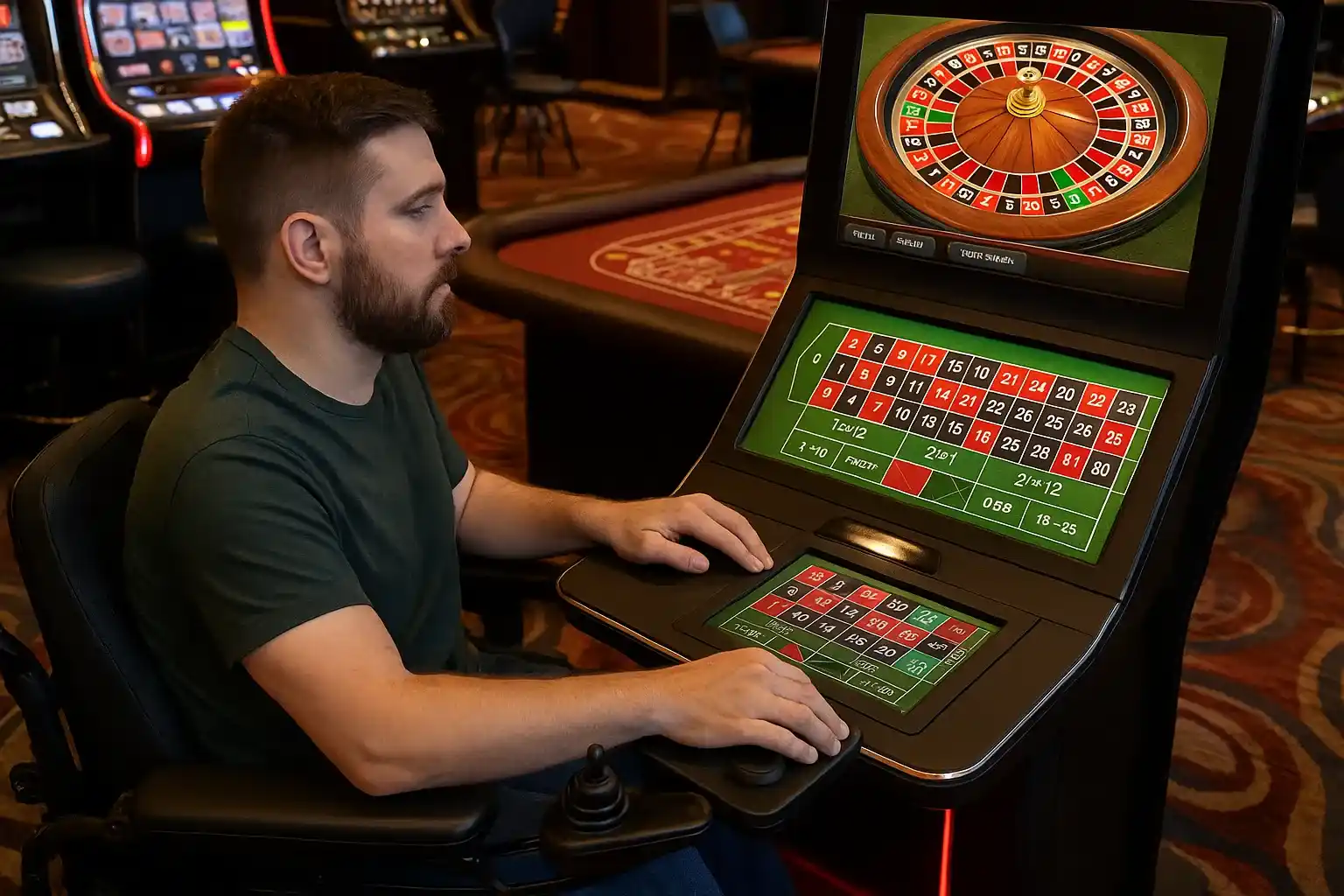Accessibility in casino gaming is no longer a niche consideration—it’s an essential part of inclusive design. From players with visual or auditory impairments to those with motor or cognitive challenges, casinos (both online and brick-and-mortar) are adapting games to ensure that everyone can enjoy the excitement responsibly. Drawing on my conversations with game developers, firsthand observations at casinos, and feedback from players with disabilities, this article explores how accessibility features are shaping the future of gaming and what practical steps the industry is taking to be truly inclusive.
Why Accessibility Matters in Casino Gaming
Imagine walking into a bustling casino, the chatter of players, blinking lights on slot machines, and the shuffle of cards at poker tables. That sensory richness can be overwhelming for someone with a sensory processing disorder or a visual impairment. Yet, gaming should be a source of entertainment and social engagement for all. Accessibility isn’t just a legal requirement under acts such as the Americans with Disabilities Act (ADA) or the Equality Act in the UK; it’s a moral imperative that demonstrates respect for every player’s unique needs.
Physical casinos have long been retrofitting entrances with ramps, installing Braille signage, and offering dealers who know basic sign language. Online casinos, however, face a different set of challenges. How do you make a slot game usable for someone who cannot see the reels or navigate a touchscreen with ease? The answer lies in thoughtful design, testing, and a deep understanding of assistive technologies.
From my discussions with accessibility consultants and product managers at leading casino software firms, one point stands out: true inclusion means co-creating features with input from affected players. Developers don’t simply guess what works—instead, they run focus groups, beta-test prototypes, and iterate until the experience feels natural. The next sections dive into specific disabilities—visual, auditory, motor, and cognitive—and show how games adapt in each area.
Visual Impairments: Adapting for Low Vision and Blind Players
One evening, I met John, a paralegal who has been completely blind since birth but loves the thrill of blackjack. He told me about his frustration with a popular online casino whose audio cues were so generic that they blended together, making it impossible to differentiate a “hit” from a “stand.” But a few months ago, that casino rolled out an accessibility update, and now John can navigate tables, place bets, and hear clear voice prompts that narrate each card. This illustrates how much difference thoughtful audio design can make.
Audio is only part of the solution. Screen reader compatibility is critical: game developers must ensure that all buttons, menus, and game states have descriptive labels that work with JAWS, NVDA, or VoiceOver. Recently, a major provider updated its slot portfolio so that the spin button reads “Spin the reels” instead of a generic “Play.” Small changes like this let a screen reader user know exactly what will happen when they press that key.
Contrast and text size are also key for players with low vision. During a visit to a Las Vegas property, I noticed that one slot machine offered a “High Contrast” mode: all reels switched to bold white on deep black, and the betting options enlarged to 150 percent of normal size. That made it usable for a player with macular degeneration standing nearby. Online, many casinos now let you toggle a “Large Text” setting that carries through to the balance, bonus notifications, and chat windows.
Some innovators have even gone further with tactile elements. One Nevada casino partnered with a Braille peripheral manufacturer to create a 3D-printed overlay that snaps onto a touchscreen, indicating the location of key buttons—spin, bet max, and help. Combined with audio narration, this gives blind players a near-native experience.
Beyond tables and slots, live dealer games can be made accessible too. Certain platforms now provide a dual audio stream: one for the genuine table sound (the dealer calling out cards) and another dedicated to narration that describes actions like “Player two placed a $50 bet on red.” It’s a subtle yet powerful addition that prevents visually impaired players from missing crucial moments.
Some players prefer alternative gaming options altogether. Those looking for a broader range of wagering choices might explore emerging markets such as UK sports betting sites not on GamStop. By ensuring that sites have proper accessible design, bettors with visual impairments can place in-play soccer or horse racing wagers with the same confidence as sighted players.
Auditory Impairments: Providing Audio Alternatives and Subtitles
For players who are deaf or hard of hearing, audio-heavy games can be exclusionary. I remember chatting with Sarah, a deaf graphic designer, who told me how frustrating it was to miss the dealer’s announcements in a live baccarat session. Even though she could see the table, she lacked context for side bets or irregular calls. That spurred the casino team to implement real-time captioning on every live stream.
In digital gaming, subtitles and visual alerts replace audio cues. Instead of hearing a chime when a bonus round triggers on a slot, players see a flashing animation paired with text like “Free Spins Activated.” Similar approaches apply to audio-based roulette announcements—“No more bets” becomes a banner across the top of the screen. Some developers also add vibration feedback on mobile; a short buzz alerts the player that it’s their turn in multiplayer poker.
Closed captioning isn’t enough if it interferes with gameplay. The best implementations let you choose font size, color, and background opacity. In my own experience, I tested a casino that initially forced captions in yellow text on white backgrounds—nearly unreadable. After feedback from the deaf community, they switched to black text on semi-transparent white boxes, and Sarah said it was a game-changer.
Casinos also offer text-based chat support in real time, allowing hard-of-hearing players to ask dealers questions or request assistance. At one European online operator, I witnessed a player use a built-in chat window to ask how many chips were left in the pot—immediately answered by the dealer through text. Integrating chat directly into the game avoids forcing players to switch to email or phone support, preserving continuity.
Motor Impairments: Customizable Controls and One-Handed Play
Players with limited mobility or dexterity face unique challenges, especially with traditional tables and button-heavy slot machines. At a recent accessibility conference, I saw a demonstration of an adaptive gaming controller—a joystick and a single big red button—that connects via USB. The manufacturer collaborated with casino software vendors to map spin, bet, and change bet size functions to that single button and joystick combos.
On mobile apps, some casinos introduced “One-Hand Mode” where tapping the screen in large target zones triggers common actions. Instead of tiny icons for each bet amount, you get oversized arrows to increase or decrease wagers. In a small study by a developer I know, participants with rheumatoid arthritis reported 80 percent fewer accidental taps after switching to one-hand layouts.
For brick-and-mortar venues, dealers are trained to recognize signals from players who cannot reach chips easily. Table heights are adjusted, and chip trays with sliding mechanisms bring the currency closer. I spoke with a craps player who uses an electric wheelchair—he appreciates that a dedicated attendant helps place bets when he flicks a small joystick to indicate where he wants to wager. That kind of human-assisted tech pairing is often as important as software tweaks.
Key remapping is another online solution. Instead of requiring players to click precise areas, you can assign “Spin” to the spacebar and “Bet Max” to the Enter key. Coupled with keyboard navigation for menus—using Tab, Shift+Tab, and arrow keys—a player can enjoy an entire gaming session without relying on a mouse or touchscreen. Online casino developers rely on the Web Content Accessibility Guidelines (WCAG) to ensure every interactive element has keyboard focus and logical tab order.
Cognitive and Learning Disabilities: Simplified Interfaces and Support
Players with dyslexia, ADHD, or other cognitive challenges can become easily overwhelmed by cluttered game interfaces. When I toured a Swedish online casino’s accessibility lab, they showed me version A of a blackjack table: dozens of buttons, popups, and scrolling text. Version B trimmed everything down—just the essentials: hit, stand, double, surrender—each represented by a clear icon and a short label below. Beta testers with learning disabilities reported 70 percent fewer misclicks.
Cognitive load is further reduced by consistent layouts across games. Instead of reinventing navigation for every slot theme, the spin button stays in the lower right, the balance in the upper right, and the menu icon in the upper left. That predictability means players spend less time relearning and more time enjoying.
Teach-yourself modes or interactive tutorials help too. One Italian operator includes a “Practice Mode” where players can experiment with a fully narrated tutorial overlay. When you hover over the bet size, a small text bubble explains, “Adjust your wager by clicking + or –.” That guided approach benefits first-time players and those who struggle with working memory.
For games requiring calculations—like video poker—some sites offer an optional “Simple Mode” that plays the best mathematical strategy automatically. That way, a player with dyscalculia can choose to hold only the cards recommended by the system, with no need to manually analyze odds. Other players still have the option to make decisions themselves, preserving autonomy.
Real-World Examples and Success Stories
Several major providers have made notable strides:
• Microgaming Accessibility Suite: In 2023, they launched a collection of slots that adhere to WCAG 2.1 AA standards. One slot game features audio descriptions, large buttons, and customizable color settings. Feedback from visually impaired testers was overwhelmingly positive—players reported feeling more confident placing bets independently.
• Caesars Entertainment ADA Program: Across its 20-plus casinos, Caesars offers assistive listening devices at both poker and blackjack tables, large-print rule sheets, and accessible kiosks with touchscreen alternatives. A wheelchair user I spoke with praised Caesars for ensuring game tables met wheelchair clearance guidelines, allowing him to play craps without assistance.
• UK Online Operator with Inclusive Design: A UK-based casino revamped its entire site to meet Level AAA WCAG criteria. They involved players with various disabilities in the design process. The result? A 15 percent increase in new accounts from users who self-identified as having a disability, proving that accessibility investments can broaden the customer base.
These successes illustrate that accessibility is not just compliance—it can be a competitive advantage, driving loyalty and positive word of mouth.
The Role of Regulations and Industry Standards
Regulatory bodies around the world are catching up to technological advances. In the EU, the European Accessibility Act requires digital services—including online gambling—to be accessible by 2025. In the U.S., the ADA has been applied to certain online services, and in 2021, a landmark ruling mandated that specific gaming websites institute accessibility features.
Online gambling commissions in the UK and Australia now request proof of accessibility testing before granting licenses. They may ask for screen reader compatibility reports, user testing logs, and compliance checklists. In the UK, the Gambling Commission provides guidance on responsible gambling, emphasizing that protecting vulnerable players includes accommodating disabilities.
Industry standards like the International Association of Accessibility Professionals (IAAP) offer certifications for developers who demonstrate expertise in accessible design. Partnering with such organizations gives credibility and ensures that features meet established best practices. Inclusive design should be treated as a core requirement, not an afterthought.
Future Trends in Accessible Casino Gaming
What’s next on the horizon? From my conversations with UX designers and tech evangelists, several emerging trends stand out:
• Voice-Activated Gaming: Amazon Alexa and Google Assistant integrations could let players place bets, spin slots, or join poker tables using voice commands. For a player with limited mobility, this hands-free approach reduces barriers even further.
• Haptic Feedback and Wearables: Imagine a smart bracelet that pulses when it’s your turn in a multiplayer blackjack game or vibrates gently when a slot bonus triggers. Early prototypes are already in testing phases, promising an extra sensory layer for players with both hearing and visual impairments.
• AI-Powered Personalization: Adaptive interfaces that learn each user’s preferences—font size, contrast, audio volume—automatically adjust whenever they log in. This eliminates the need to manually configure settings each session.
• VR and AR Accessibility Layers: As VR casinos grow, developers are exploring 3D audio and text-to-speech narrations within virtual worlds. Accessible VR lobbies might include narrated menus or contrast-boosted avatars that guide a player to their preferred games.
• Collaborative Platforms: Community-driven forums where players with disabilities share tips and feedback. Some operators already host monthly “Accessibility Roundtables” to discuss feature requests and bug reports directly with developers.
The combination of evolving technology and stronger regulations means that accessibility in casino gaming will only accelerate. Developers who embrace this now will be ahead of the curve, fostering loyalty among a diverse player base.
Final Thoughts
Designing casino games for accessibility is both a challenge and an opportunity. From immersive audio descriptions for visually impaired players to simplified interfaces for those with cognitive disabilities, every thoughtful feature helps make gaming more inclusive. Whether you’re a game developer, casino operator, or player advocating for change, the key takeaway is that true accessibility requires ongoing collaboration, testing, and empathy.
While the road to full inclusion is long—especially as new technologies emerge—current advancements demonstrate that meaningful progress is possible. As someone who has witnessed casino floors transform and online platforms evolve, I’m optimistic. The next time you see a player in a wheelchair triumphantly place a bet unaided, or hear a slot reel’s outcome described clearly by a voiceover, you’ll know how far we’ve come. By centering the needs of all players, casino gaming can become a space where everyone, regardless of ability, can participate fully and enjoyably.




